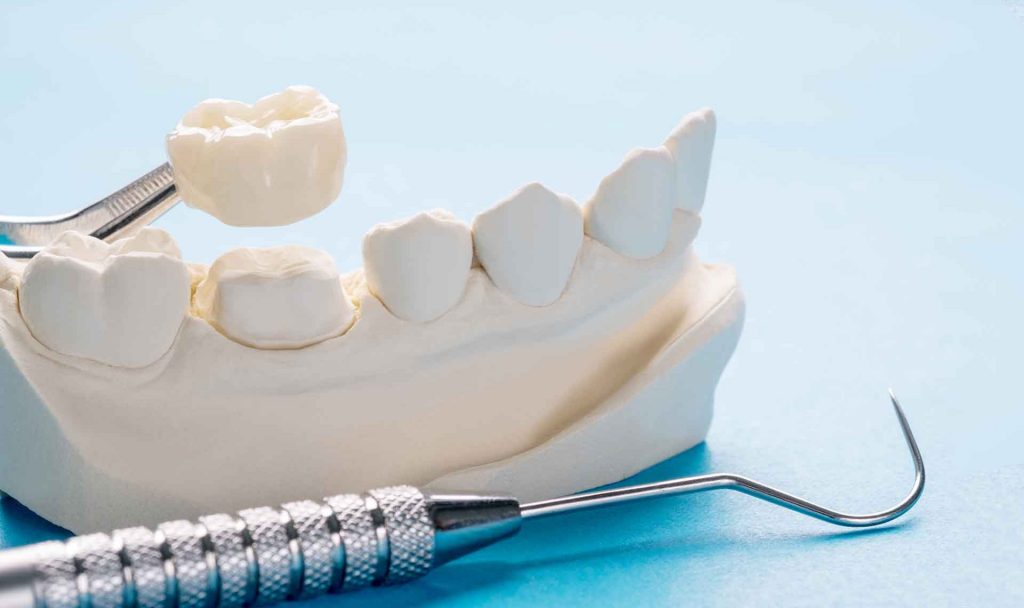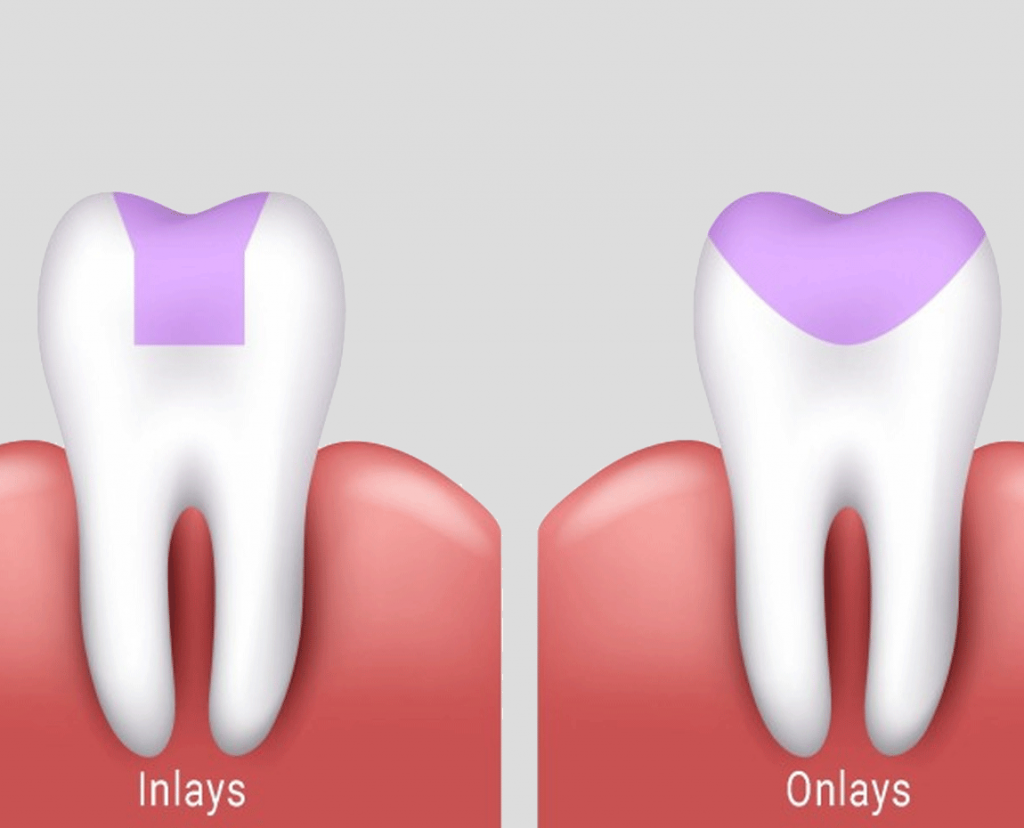CROWNS, INLAYS & ONLAYS
Protect your teeth with long-lasting, aesthetic crowns that are designed to dazzle
What are crowns?
Crowns are a type of dental restoration that completely encase a tooth to give it optimum protection.
They can be made from a variety of materials including zirconia, lithium disilicate, metal, or a combination of both. Crowns are often used to strengthen a damaged or decayed tooth and/or to improve the appearance of a tooth.
Porcelain crowns are made to fit perfectly in terms of size and shape. They’re completely natural in appearance and are indistinguishable from the rest of your teeth. We can even colour-match your new crown with your existing teeth.

Which material is best for a crown?
The best material for a crown depends on the individual case, the location of the tooth, and your own preferences. The most common materials used for dental crowns are:
All-ceramic or all-porcelain: These types of crowns are made entirely of porcelain or ceramic material, which can look more natural. They can be used in any location of the mouth, but are popular on front teeth.
Gold: These are very durable, and have been used for decades to withstand forces of biting and chewing. However, they are traditionally reserved for back teeth, where they are less likely to be seen.
Zirconia: This is a very strong, tooth-coloured material that can be used for both front and back teeth.
Your dentist will take many factors into consideration, before offering you the best options for your individual situation.
Getting a crown made typically involves two visits to Belwell Dental.
During the first visit, the tooth will be prepared and an impression or scan will be taken. A temporary crown will be placed to protect the tooth while the permanent crown is being made.
On the second visit, the permanent crown will be checked for fit, colour and cemented in place.
You may experience some sensitivity or discomfort for a few days after the procedure. This is perfectly normal, and we will provide you with instructions on how to care for your new crown and ensure that you are comfortable throughout the entire process.

Which material is best for a crown?
The best material for a crown depends on the individual case, the location of the tooth, and your own preferences. The most common materials used for dental crowns are:
All-ceramic or all-porcelain: These types of crowns are made entirely of porcelain or ceramic material, which can look more natural. They can be used in any location of the mouth, but are popular on front teeth.
Gold: These are very durable, and have been used for decades to withstand forces of biting and chewing. However, they are traditionally reserved for back teeth, where they are less likely to be seen.
Zirconia: This is a very strong, tooth-coloured material that can be used for both front and back teeth.
Your dentist will take many factors into consideration, before offering you the best options for your individual situation.
Getting a crown made typically involves two visits to Belwell Dental.
During the first visit, the tooth will be prepared and an impression or scan will be taken. A temporary crown will be placed to protect the tooth while the permanent crown is being made.
On the second visit, the permanent crown will be checked for fit, colour and cemented in place.
You may experience some sensitivity or discomfort for a few days after the procedure. This is perfectly normal, and we will provide you with instructions on how to care for your new crown and ensure that you are comfortable throughout the entire process.
RESTORE, REPAIR & PROTECT YOUR TEETH WITH CROWNS, INLAYS OR ONLAYS
At Belwell Dental, we offer a range of options for tooth restoration, including crowns, inlays, and onlays.
Inlays & Onlays
What are they?
Similar to fillings, inlays and onlays are used to restore a tooth’s integrity and function following damage. The difference being that, whereas a standard filling is applied directly into/onto your tooth and hardens in your mouth, inlays and onlays are custom-made in the laboratory and then cemented in place.
- Inlays and onlays are used when the tooth structure is not sufficient enough to place a regular filling and the result is much stronger.
- The difference between inlays and onlays is that an inlay is placed inside a cavity on your tooth whilst an onlay replaces the cusp(s) (tips) of your tooth. These two terms are often used interchangeably.


RESTORATIVE DENTISTRY - CROWNS, INLAYS OR ONLAYS?
Dental crowns, inlays and onlays are all restorative treatments with each having its own pro’s and con’s, the advantage that dental onlays have over crowns for restoration is that they are more conservative and require removing the affected part of the tooth only. This preserves more of the natural tooth structure and reduces treatment requirements. The advantage of a crown is that it covers the biting surface of the tooth completely, including the tooth structure above the gum line. The significant difference between an onlay and an inlay is that while an onlay covers the tooth cusp, the inlay only fills parts of the cusps.
Your dentist at Belwell Dental is better placed to determine if a crown, onlay or inlay will be required for a restoration treatment. Some of the factors they will consider are previous dental work, the severity of the damage, the extent of tooth sensitivity, and the urgency of the treatment.
These elements help your dentist decide which treatment will be the most effective to protect the tooth’s structure. To learn more about these dental restoration options use the button below.
RESTORATIVE DENTISTRY - CROWNS, INLAYS OR ONLAYS?
Dental crowns, inlays and onlays are all restorative treatments with each having its own pro’s and con’s, the advantage that dental onlays have over crowns for restoration is that they are more conservative and require removing the affected part of the tooth only. This preserves more of the natural tooth structure and reduces treatment requirements. The advantage of a crown is that it covers the biting surface of the tooth completely, including the tooth structure above the gum line. The significant difference between an onlay and an inlay is that while an onlay covers the tooth cusp, the inlay only fills parts of the cusps.
Your dentist at Belwell Dental is better placed to determine if a crown, onlay or inlay will be required for a restoration treatment. Some of the factors they will consider are previous dental work, the severity of the damage, the extent of tooth sensitivity, and the urgency of the treatment.
These elements help your dentist decide which treatment will be the most effective to protect the tooth’s structure. To learn more about these dental restoration options use the button below.


